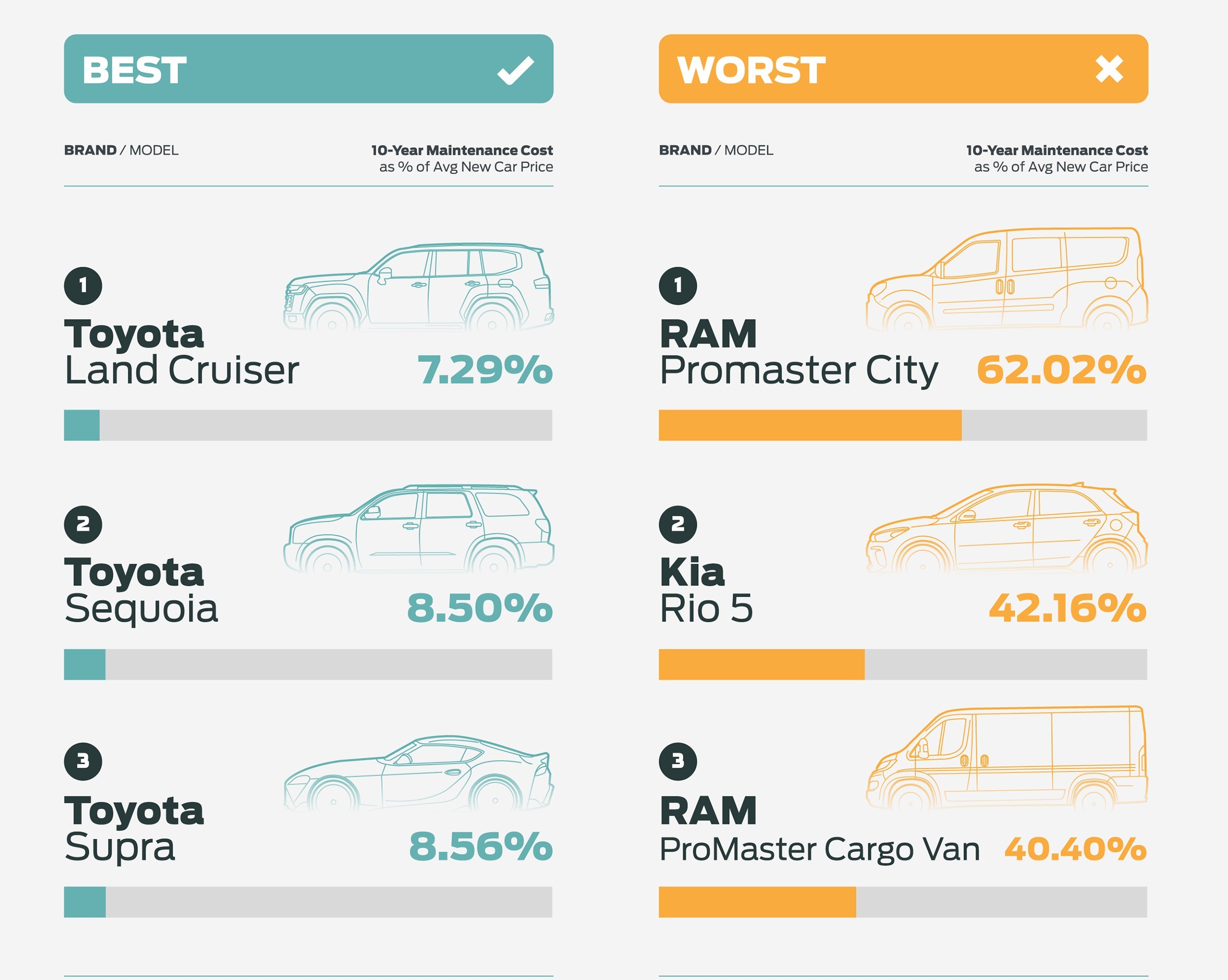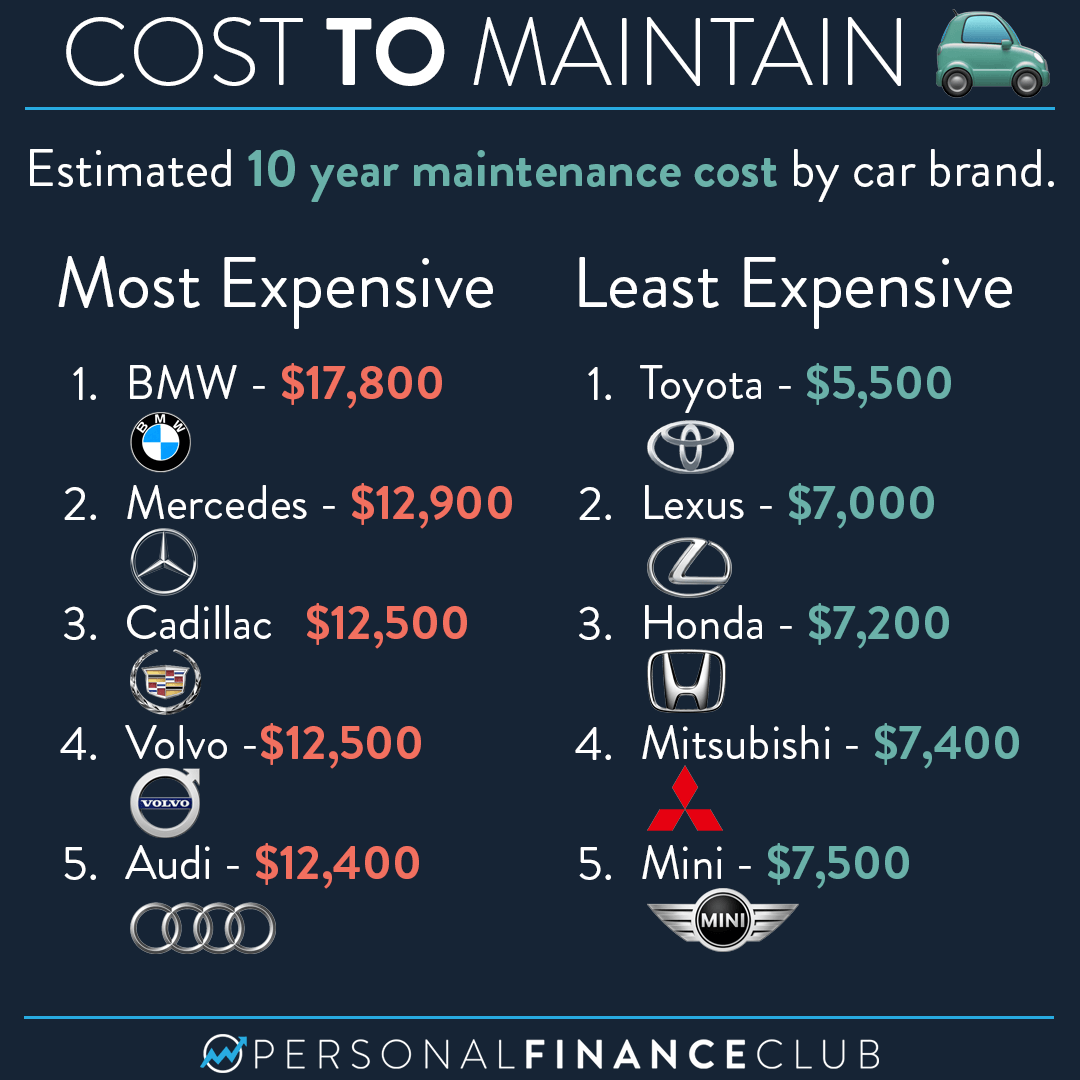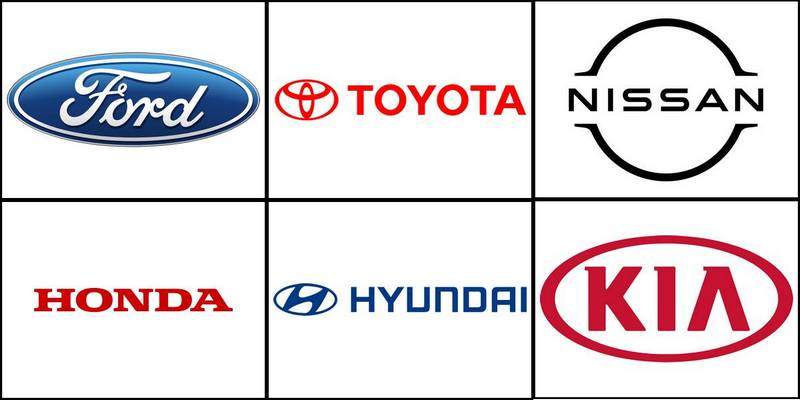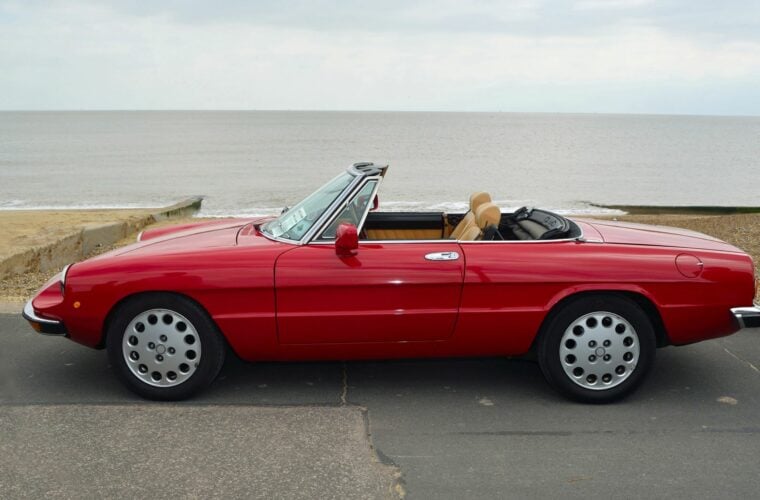Cheapest Car Brands To Maintain: A Comprehensive Guide to Savvy Car Ownership
Cheapest Car Brands To Maintain: A Comprehensive Guide to Savvy Car Ownership cars.truckstrend.com
In the world of car ownership, the initial purchase price is often just the tip of the iceberg. Beneath the surface lie a myriad of ongoing expenses, with maintenance costs being one of the most significant. Understanding which car brands are historically the cheapest to maintain can save you thousands of dollars over the lifetime of a vehicle, turning what could be a financial drain into a manageable and predictable expense. This comprehensive guide will delve into the factors that influence maintenance costs, highlight the brands that consistently rank high for affordability, and provide practical advice for minimizing your overall car ownership expenses.
Understanding Car Maintenance Costs: Beyond the Sticker Price
Cheapest Car Brands To Maintain: A Comprehensive Guide to Savvy Car Ownership
Before we identify the cheapest brands, it’s crucial to grasp what constitutes "maintenance costs." It’s more than just fixing something when it breaks. The total cost of ownership (TCO) includes several elements:
- Routine Maintenance: Scheduled services like oil changes, tire rotations, filter replacements (air, cabin, fuel), fluid checks, and spark plug replacements. These are preventative measures designed to keep your car running smoothly and prevent larger issues.
- Common Repairs: Wear-and-tear items that need periodic replacement, such as brake pads and rotors, tires, batteries, and belts.
- Unexpected Repairs: Major component failures like transmission issues, engine problems, or complex electrical system repairs. These are often the most costly and unpredictable.
- Fuel Costs: While not directly "maintenance," fuel efficiency significantly impacts running costs.
- Insurance Premiums: Insurers consider vehicle repair costs and parts availability when setting premiums.
- Depreciation: The loss of value over time. While not a direct maintenance cost, it’s the single largest cost of car ownership.

Our focus here will primarily be on routine and unexpected repair costs, as these are most directly tied to a brand’s reliability and design.
Key Factors Influencing Low Maintenance Costs
Several attributes contribute to a car brand’s reputation for low maintenance costs:
- Exceptional Reliability: This is paramount. Fewer breakdowns mean fewer unexpected repair bills. Brands that engineer durable components and rigorously test their vehicles tend to have lower long-term costs.
- Affordable and Readily Available Parts: Commonality of parts across models, high production volumes, and strong aftermarket support drive down part prices. If a part is obscure or only available through a dealership at a premium, costs skyrocket.
- Simplicity of Design and Engineering: Less complex systems are often easier and quicker for mechanics to diagnose and repair, leading to lower labor costs. Overly intricate designs, especially in luxury vehicles, can involve specialized tools and training, increasing repair expenses.
- Widespread Service Network & Mechanic Familiarity: When mechanics across the country are familiar with a brand’s common issues and repair procedures, it leads to more efficient and often cheaper service.
- Strong Manufacturer Warranties: While not directly reducing maintenance, a comprehensive warranty can cover major unexpected repairs, significantly mitigating your out-of-pocket expenses during the warranty period.
- Good Fuel Efficiency: While separate from repair costs, lower fuel consumption contributes to a lower overall cost of ownership.


Top Contenders: Cheapest Car Brands To Maintain
Based on decades of data from consumer reports, automotive studies, and mechanic feedback, several brands consistently stand out for their low maintenance costs. They excel in reliability, parts availability, and ease of repair.
1. Toyota
Why they’re cheap to maintain: Toyota’s legendary reputation for reliability is well-earned. Their vehicles are designed for longevity, with robust powertrains and well-engineered components that stand the test of time. Parts are abundant, competitively priced, and readily available globally, both OEM and aftermarket. Mechanics everywhere are familiar with Toyota vehicles, making diagnostics and repairs straightforward.
Examples:
- Toyota Corolla: Often cited as one of the cheapest cars to maintain, known for its bulletproof reliability and efficiency.
- Toyota Camry: A mid-size sedan offering similar reliability and low running costs on a slightly larger platform.
- Toyota Prius: Despite its hybrid technology, the Prius has proven remarkably reliable, with hybrid system components often lasting well over 150,000 miles.
2. Honda
Why they’re cheap to maintain: Honda mirrors many of Toyota’s strengths, offering exceptional reliability, strong resale values, and efficient engines. Their engineering focuses on durability and practical design, making them less prone to major issues. Parts are widely available and reasonably priced.
Examples:
- Honda Civic: A perennial favorite for its reliability, fuel economy, and low ownership costs.
- Honda CR-V: A highly popular compact SUV that shares the Civic’s reputation for dependability.
- Honda Accord: A mid-size sedan known for its balanced performance and long-term reliability.
3. Hyundai / Kia (and Genesis)
Why they’re cheap to maintain: In recent decades, Hyundai and Kia (sister companies) have made incredible strides in quality, reliability, and technology. They back their vehicles with some of the industry’s best warranties (e.g., 10-year/100,000-mile powertrain warranty), which significantly reduces the risk of unexpected major repair costs for the original owner. Parts availability has improved dramatically, and their models are generally straightforward to service.
Examples:
- Hyundai Elantra: A compact sedan offering great value and improving reliability.
- Kia Forte: Kia’s counterpart to the Elantra, also providing competitive reliability and features.
- Hyundai Kona / Kia Seltos: Popular compact SUVs that offer good reliability for their segment.
4. Mazda
Why they’re cheap to maintain: Mazda has quietly built a reputation for excellent reliability and driving dynamics. While often overshadowed by Toyota and Honda, Mazda’s engineering philosophy emphasizes simple, robust designs (like their Skyactiv engines) that are less prone to complex issues. Their parts are generally affordable, and their vehicles are proving to be very durable over the long term.
Examples:
- Mazda3: A stylish and engaging compact car with impressive reliability.
- Mazda CX-5: A highly regarded compact SUV that consistently ranks high in reliability surveys.
5. Subaru
Why they’re cheap to maintain: Subaru is known for its standard all-wheel-drive systems and robust build quality, making them popular in regions with challenging weather. While some specific issues related to their Boxer engines (e.g., head gaskets on older models) could be costly, modern Subarus (especially the Impreza, Forester, and Outback) have significantly improved in reliability. Their commonality in certain regions means mechanics are well-versed in their maintenance.
Examples:
- Subaru Impreza: A solid, reliable compact car with standard AWD.
- Subaru Forester: A popular compact SUV known for its practicality and all-weather capability.
Practical Advice and Actionable Insights for Minimizing Car Maintenance Costs
Even with a reliable brand, your actions as an owner play a huge role in minimizing costs:
- Adhere to the Manufacturer’s Maintenance Schedule: This is the golden rule. Preventative maintenance (oil changes, tire rotations, fluid checks) catches small issues before they become expensive problems. Don’t skip or delay scheduled services.
- Find a Reputable and Affordable Mechanic: While dealerships offer convenience, independent mechanics often have lower labor rates. Look for ASE-certified technicians and read reviews. Build a relationship with a trusted shop.
- Learn Basic DIY Maintenance: Changing your own air filter, cabin filter, wiper blades, or checking fluid levels can save you money and give you a better understanding of your vehicle.
- Shop Around for Parts: For out-of-warranty repairs, don’t be afraid to ask your mechanic about using aftermarket parts (often identical to OEM but without the brand markup) or even sourcing parts yourself from reputable online retailers.
- Drive Responsibly: Aggressive driving (hard acceleration, sudden braking) puts more strain on your engine, brakes, and tires, leading to faster wear and tear. Smooth driving extends component life and saves on fuel.
- Keep Meticulous Records: A well-documented service history is invaluable. It helps you track maintenance, troubleshoot issues, and significantly boosts resale value.
- Understand Your Warranty: Know precisely what your vehicle’s warranty covers and for how long. This can save you from unexpected costs for major components.
- Consider a Pre-Purchase Inspection for Used Cars: Before buying a used vehicle, invest in a pre-purchase inspection by an independent mechanic. This can uncover hidden issues that might lead to costly repairs down the line.
Challenges and Considerations
While aiming for low maintenance costs, keep these points in mind:
- Initial Purchase Price vs. Long-Term Cost: A car that’s cheap to buy might be expensive to own if it’s unreliable. Always look at the total cost of ownership.
- Regional Differences: Labor rates and parts availability can vary significantly by geographic location, influencing overall costs.
- Model-Specific Variations: Even within a reliable brand, specific models or engine configurations might have known issues that increase maintenance costs. Research the exact model and year you’re considering.
- Owner Habits: Your driving style, maintenance habits, and even the climate you live in will influence how often and how much your car needs repairs.
- Age of Vehicle: All cars, regardless of brand, will require more frequent and potentially more expensive maintenance as they age and accumulate mileage.
Estimated Annual Maintenance Costs: A Comparative Table
Below is an estimated annual maintenance cost comparison for popular models from the brands discussed. These are average figures and can vary based on model year, mileage, driving habits, and location.
| Brand | Model (Example) | Estimated Annual Maintenance Cost (USD) | Key Factor for Low Cost |
|---|---|---|---|
| Toyota | Corolla | $360 – $450 | Legendary reliability, abundant & affordable parts |
| Camry | $380 – $470 | Strong durability, widespread mechanic familiarity | |
| Honda | Civic | $400 – $480 | Excellent reliability, efficient engines, good resale |
| CR-V | $420 – $520 | Durable components, easy to service | |
| Hyundai | Elantra | $450 – $550 | Improved reliability, long warranty, competitive parts |
| Kia | Forte | $460 – $560 | Value-for-money, strong warranty support |
| Mazda | Mazda3 | $430 – $530 | Robust engineering, reliable Skyactiv powertrains |
| CX-5 | $450 – $550 | High reliability ratings, straightforward design | |
| Subaru | Impreza | $500 – $600 | All-wheel-drive reliability, robust build quality |
| Forester | $520 – $620 | Durable for all conditions, common in certain regions |
Note: These figures are general estimates based on various industry data sources and are subject to change. They primarily cover routine maintenance and common wear-and-tear items for vehicles under 100,000 miles. Major unexpected repairs are not included in these averages.
Frequently Asked Questions (FAQ)
Q1: Are luxury cars always more expensive to maintain?
A1: Generally, yes. Luxury brands (e.g., BMW, Mercedes-Benz, Audi, Porsche) often use specialized parts, complex electronic systems, and require specific diagnostic tools and highly trained technicians. Their parts are typically more expensive, and labor rates at their dealerships are higher.
Q2: Does buying a used car save on maintenance?
A2: Not necessarily. While the initial purchase price is lower, older used cars generally require more frequent and potentially more expensive maintenance and repairs as components wear out. The savings from the lower purchase price might be offset by higher running costs. A well-maintained used car from a reliable brand can be a good balance.
Q3: How much should I budget for car maintenance annually?
A3: A good rule of thumb is to budget 1% of the vehicle’s original purchase price annually for maintenance and repairs, or about $500-$1000 for an average non-luxury car, increasing for older or higher-mileage vehicles. Some experts suggest setting aside $0.10 to $0.15 per mile driven.
Q4: Is electric car maintenance cheaper than gasoline cars?
A4: Yes, typically. Electric vehicles (EVs) have far fewer moving parts than internal combustion engine (ICE) vehicles. They don’t require oil changes, spark plug replacements, or exhaust system repairs. Routine maintenance often involves tire rotations, brake checks (regenerative braking reduces brake wear), and cabin air filter replacements. Battery replacement is the main potential high cost, but batteries are designed to last for many years and are often covered by long warranties.
Q5: Do warranties cover all maintenance costs?
A5: No. Manufacturer warranties typically cover defects in materials or workmanship, meaning they cover repairs if a component fails prematurely due to a manufacturing flaw. They do not cover routine maintenance (oil changes, tire rotations, brake pads, filters) or wear-and-tear items, which are considered normal operating expenses. Extended warranties or specific maintenance plans can cover some of these, but they come at an additional cost.
Conclusion
Choosing a car brand known for its low maintenance costs is one of the smartest financial decisions you can make as a car owner. Brands like Toyota, Honda, Hyundai, Kia, and Mazda consistently demonstrate a commitment to reliability, affordability of parts, and straightforward engineering, translating into significant long-term savings. However, a brand’s reputation is only part of the equation. Your proactive approach to preventative maintenance, responsible driving habits, and savvy choices in service and parts will ultimately determine your vehicle’s true cost of ownership. By combining a reliable choice with diligent care, you can enjoy years of worry-free driving without breaking the bank.




